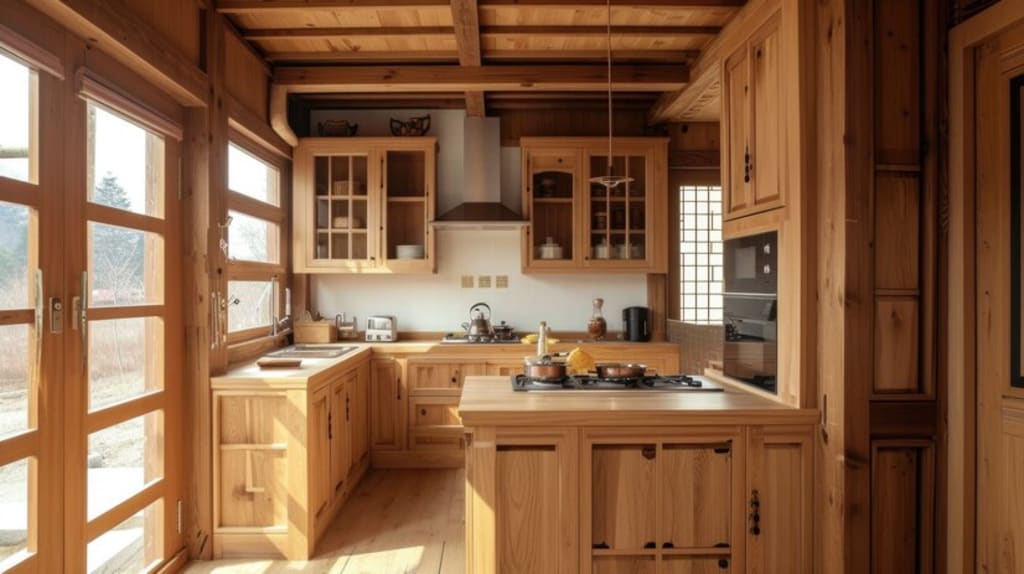How does a Wood hood vent work?
Keeping Your Kitchen Smoke-Free: The Power of Wood Hood Vents

The warm glow of a wood fire creates a sense of comfort and ambiance in a home. But wood smoke can also leave your kitchen feeling stuffy and smelling less than desirable. This is where a wood hood vent comes in, silently working in the background to ensure a pleasant cooking environment. But how exactly does this seemingly simple piece of equipment achieve such a feat?
The Science of Vent Efficiency
At its core, a wood hood vent functions like any other kitchen exhaust system. Here's a breakdown of the key components and their roles:
Capture Panel: Also known as the hood, this angled piece sits above your cooktop or stove. Its design helps contain the rising smoke, grease, and heat generated while cooking.
Grease Filter: This is typically a metallic mesh that traps airborne grease particles before they can enter the ductwork. Regular cleaning of the filter is crucial to maintain optimal airflow and prevent fire hazards.
Blower Fan: The powerhouse of the system, the blower fan creates suction, drawing smoke, steam, and odors away from the cooking surface and into the ductwork.
Ductwork: This network of pipes channels the extracted air from your kitchen to the outdoors. Proper installation with minimal bends and the right diameter is essential for efficient airflow.
Vent Cap: Located on the exterior of your house, the vent cap allows the expelled air to escape and prevents back-drafting. Some caps may incorporate a damper that opens when the fan is running and closes when idle.
Ducted vs. Ductless: Choosing the Right Wood Hood Vent
There are two main types of wood hood vents to consider: ducted and ductless.
Ducted Systems: These are the most effective options for channeling smoke and odors directly outside your home. They require professional installation to ensure proper ductwork placement and sizing.
Ductless Systems: These are a viable alternative for situations where ductwork installation is impractical. They utilize charcoal filters to trap odors and grease particles, recirculating the cleaned air back into the kitchen. However, ductless hood vent systems are generally less effective at removing smoke and moisture than ducted systems.
Optimizing Wood Hood Vent Performance
To ensure your wood hood vent functions at its peak, follow these tips:
Turn on the vent before you start cooking: This allows the system to establish proper airflow and capture smoke from the get-go.
Adjust the fan speed: Higher speeds are ideal for heavy-duty cooking or dealing with stubborn smoke.
Maintain a clean filter: Regularly clean or replace the grease filter according to the manufacturer's instructions. A clogged filter restricts airflow and reduces efficiency.
Consider vent size: The size of your hood and fan should be proportionate to the size of your cooktop to ensure adequate capture of airborne contaminants.
Beyond Functionality
Wood hood vents aren't just about functionality; they can also add a touch of rustic charm or classic elegance to your kitchen. With a variety of wood types, finishes, and styles to choose from, you can find a vent that complements your existing décor.
Here are some additional factors to consider when selecting a wood hood vent:
Wood type: Popular choices include cherry, oak, maple, and walnut. Each wood offers unique aesthetic qualities and durability factors.
Finishing: Consider stained, painted, or natural wood finishes to match your kitchen cabinetry or create a desired contrast.
Style: From traditional to contemporary, the style of your vent should blend seamlessly with your overall kitchen design.
Conclusion
By understanding the mechanics of wood hood vents and following these tips, you can ensure your kitchen stays free of smoke, odors, and excessive heat. With a well-functioning vent and a touch of rustic charm, you can create a comfortable and inviting space to enjoy the warmth and ambiance of a wood fire.
For more information, visit our Website
About the Creator
Enjoyed the story? Support the Creator.
Subscribe for free to receive all their stories in your feed. You could also pledge your support or give them a one-off tip, letting them know you appreciate their work.






Comments
There are no comments for this story
Be the first to respond and start the conversation.